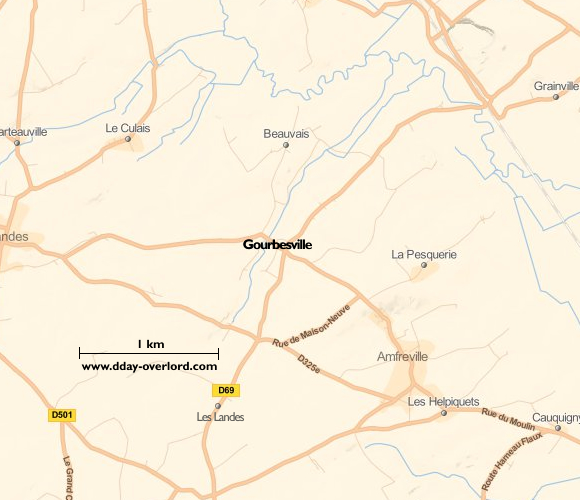Gourbesville (Manche)
The cities of Normandy during the 1944 battles
- Liberation: June 15, 1944
- Deployed units:
![]() 325th Glider Infantry Regiment, 82nd Airborne Division
325th Glider Infantry Regiment, 82nd Airborne Division
![]() 505th Parachute Infantry Regiment, 82nd Airborne Division
505th Parachute Infantry Regiment, 82nd Airborne Division
![]() 507th Parachute Infantry Regiment, 82nd Airborne Division
507th Parachute Infantry Regiment, 82nd Airborne Division
![]() 508th Parachute Infantry Regiment, 82nd Airborne Division
508th Parachute Infantry Regiment, 82nd Airborne Division
![]() 357th Infantry Regiment, 90th Infantry Division
357th Infantry Regiment, 90th Infantry Division
![]() Grenadier-Regiment 1057, 91. Infanterie-Division
Grenadier-Regiment 1057, 91. Infanterie-Division
![]() III/Grenadier-Regiment 1058, 91. Infanterie-Division
III/Grenadier-Regiment 1058, 91. Infanterie-Division
- History:
In the spring of 1944, the village of Gourbesville was placed under the responsibility of Grenadier-Regiment 1058 (91. Infanterie-Division). During the preparation phase of Operation Overlord, the Allies place this municipality at the northwest end of the bridgehead that US paratroopers must control on D-Day. For this purpose, a “drop zone” is chosen in the immediate vicinity of Gourbesville and is coded “T”. It is the 507th Parachute Infantry Regiment (82nd Airborne Division) commanded by Colonel George V. Millet who is in charge of seizing it.
In the early hours of June 6, 1944, the scouts were dropped to mark the “DZ” T zone. But the Germans patrolled in the area and prevented the Americans from accomplishing their crucial task of marking. Only the stick number 2 under the command of Lieutenant Charles Ames manages to activate the Eureka system which communicates directly with the transport planes C-47. In addition, the launch series for the DZ T face a large anti-aircraft artillery barrage during their passage over the Cotentin. These shots, which are not very precise but very numerous, disorient the pilots and cause a feeling of panic within the formations held by the C-47s. The parachuting of the 507th PIR, which starts at 2 hours 39, takes place in very bad conditions: three sticks only land in the immediate vicinity of the DZ. The others are dispersed in the region, particularly in the marshes around the Merderet, and 180 paratroopers are dropped more than 20 kilometers from their jump zone.
Several American soldiers from the 507th PIR and the 508th PIR are dropped at Gourbesville and those taken prisoner are transferred there. Disorganized, the paratroopers of the 507th PIR concentrate their efforts south-east of Gourbesville, at the level of the roadway of La Fiere, a nerve center of the region. Thus, the fighting for the liberation of the commune begins a week after D-Day.
In the night of June 13-14, 1944, the 357th Infantry Regiment commanded by Colonel Philip H. Ginder and belonging to the 90th Infantry Division was parked for the night only one kilometer south-east of Gourbesville. An aerial bombardment, scheduled for 14 June at 1400 hours in preparation for the assault on the village, was canceled due to marking problems on the ground and was replaced at 1800 by artillery fire. Problems of coordination, American shells fall on the lines of the 3rd battalion and the attack that was to follow is a fiasco. The 357th Infantry Regiment reorganized and then, after a new artillery fire at 7:30 pm, the Americans managed to enter Gourbesville at 10:30 pm The fighting lasted all night, the Germans still occupying several houses in the village .
It still takes the whole day of June 15 and many American losses to obtain the complete liberation of Gourbesville.
Gourbesville maps:

